Warehouse
Closed
July 10, 2026
Judging
Date
July 26, 2026
Winners
Announced
August 12, 2026
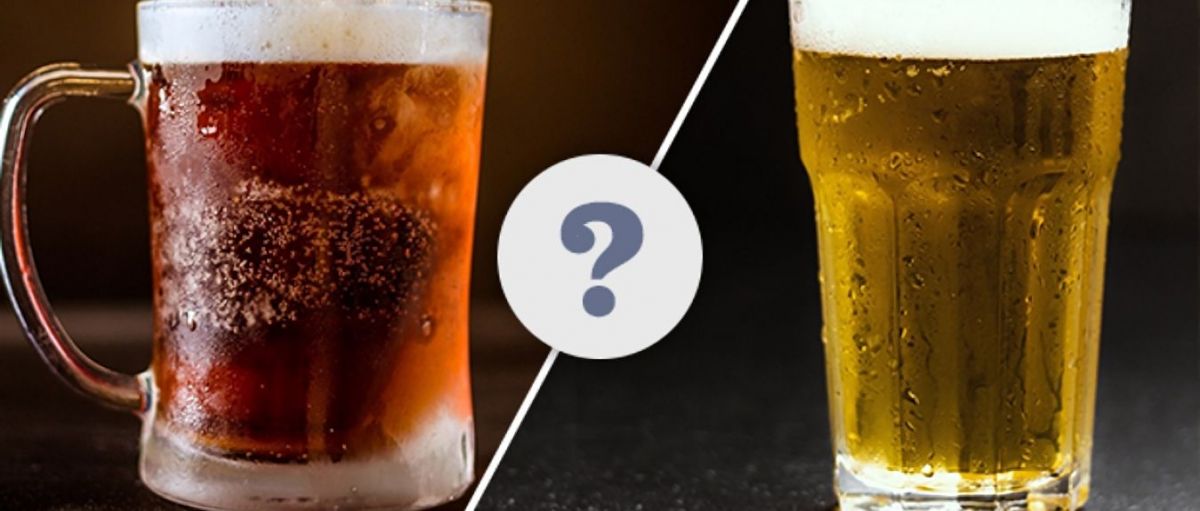
Beer is a centuries-old beverage. Different regions of the world have produced different styles. The variances result from a combination of the ingredients available for manufacture and consumer preferences, ranging from hop-forward IPAs and rich dessert-like stouts to tangy sours and crisp, mild pilsners. Understanding beer, what it contains, is the first step in determining the difference between ale and lager.
Let's look at some fundamental characteristics between ales and lagers to help you understand how they differ and assist you through the brewing process.
Beer is a carbonated alcoholic beverage created from fermented grains (primarily barley), hops, and water.
Step 1: Malting involves heating, drying, and cracking the grain to release the enzymes required for fermentation. The color of the beer is determined by the malt used. Lightly roasted malts yield very pale beers, whereas extensively roasted malts produce dark beers.
[[relatedPurchasesItems-43]]
Step 2: To make a mash, combine the malt (crushed grain) with boiling water. "For about an hour, the malt is steeped in hot, but not boiling, water to activate enzymes in the malt that cause the starch to break down and release simple sugars." Then, the malt is separated from the water through sieves present in the lauter tun.
Finally, the remaining sticky sweet liquid, known as wort, rich in fermentable carbohydrates, is transferred to the whirlpooling tank.
Step 3: The wort is boiled with hops (which imparts the characteristic bitterness of beer) and other flavoring ingredients before being filtered, cooled, and pumped into the fermentation tanks.
At the initial stage of the fermentation process, adding the yeast strain into the beer will determine whether the beer is classified as an ale or a lager. But there are various factors that can affect the ultimate quality, clarity, and flavor of your beer. Each of these factors, including yeast, can significantly impact how the various styles finish out in the end.
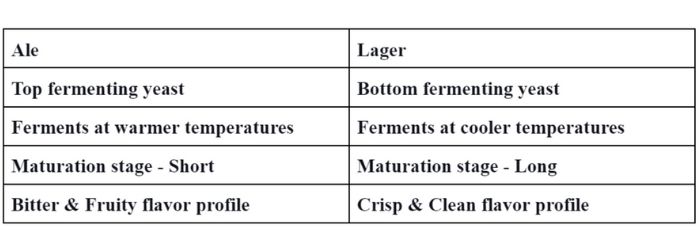
Yeast - Yeast is what gives each brew life. The yeast strain used in each beer distinguishes each type from the others. Many beer enthusiasts understand that ale utilizes top-fermenting yeast, whereas lager uses bottom-fermenting yeast. While brewing, both of these varieties disseminate throughout the fermentation vessel but will be more noticeable at the top or bottom during specific stages of the fermentation process.
Ale - The fermenting yeast used for making ale is Saccharomyces cerevisiae, a yeast widely employed in various applications, including wine and bread baking. It is known as a top-fermenting yeast because it rises to the top of the brewing vessel before sinking to the bottom when fermentation is complete. This property also makes it very simple to harvest the yeast without interfering with the process. In addition, because of the rapid action of this yeast species, the ale can be brewed in as little as a week, with the yeast products floating to the surface due to enhanced agitation within the fermentation vessel.
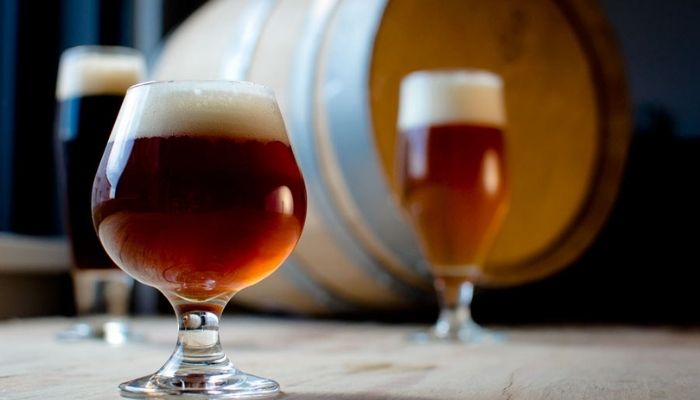
Image source: Craft Beer, Cask Ale
Lager - The fermenting yeast used to make lager is Saccharomyces uvarum. It was initially utilized for brewing in Bavaria during the Renaissance. Bottom fermenting yeast, also known as Saccharomyces uvarum, is used to produce lagers. This yeast does not necessarily ferment from the bottom, but it also does not climb to the top during fermentation, as top-fermenting yeast does. Bottom-fermenting yeast is so named because it is not visible throughout the fermentation process. In addition, this yeast is more delicate than top-fermenting yeast and requires certain growth conditions; thus, it can generate more results than ale yeast.
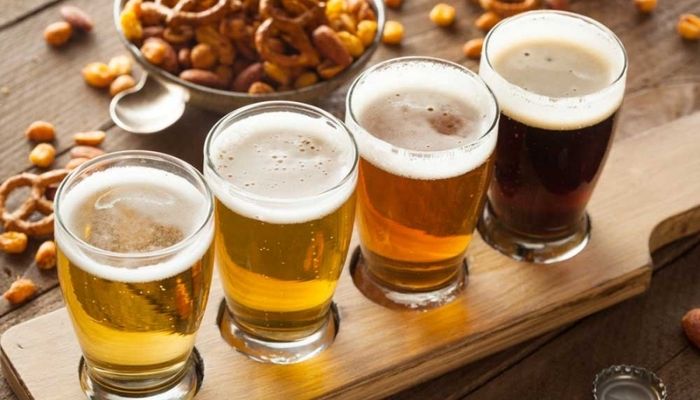
Image Source: Brewer-World, Diff Types of Lager Beer Styles
Fermentation Temperatures - The fermentation temperature varies significantly between the two yeast strains, affecting the beer's body and mouthfeel.
Because of their delicate nature and susceptibility to higher temperatures, lagers are more challenging to brew due to brewing temperatures.
Ale - Top fermenting yeasts used in ales are typically active at temperatures ranging from 60 to 80 degrees Fahrenheit, with some uncommon kinds able to survive temperatures ranging from 95 to 100 degrees Fahrenheit. Because top-fermenting yeast travels from the top of the brewing vessel to the bottom during fermentation, yeast particles scatter throughout the beer. This rapid fermentation process produces a cloudier and heavier beer, typical of many ales.
Lager - Lager yeast is substantially more delicate than ale yeast, which means it can remain active below 39°F. Most Lager strains perform admirably in the 48–55°F (9–13°C) temperature range; however, some produce lager characteristics even at higher temperatures. Because bottom-fermenting yeasts are fragile, they remain active at lower temperatures, and when brewed at lower temperatures, there is less volatile movement, resulting in a cleaner brew.
Beer's final quality, clarity, and flavor can also be influenced by factors such as alcohol percentage, hop content, and storage.
Yeast has a significant impact on the alcohol amount of a beer since its ability to thrive in high vs. low alcohol settings influences the beverage's alcohol content. Because ale yeasts can thrive at high quantities of alcohol, the resulting beer contains more alcohol. Conversely, lager yeast, frailer and slower, cannot thrive in high alcohol settings, so lager beers have a lower overall alcohol level.
The amount of hops used in ale and lager varies. Hops are present in much higher concentrations in ales, mainly because they provide a protective aspect to the beer as it ferments at higher temperatures. However, the speedier, warmer method of brewing ale may result in more bitterness in the finished beer, which can be a negative or a favorable element depending on a particular taste palate and the brewing style.
To create further clarity, Lagers also go through a cold conditioning stage that ales do not. This procedure allows more yeast, proteins, and hops to settle out of the lager, substantially enhancing clarity and lowering chill haze, which arises when an ale that has not been cold treated is cooled for the first time. The additional solids in the ale begin to generate the haze effect.
Flavor Profile - Ales are sweeter and fuller-bodied than lagers, with a bitter edge from the hops. Lagers are smoother and have more crisp aromas due to the cold, slow fermentation.
Pilsners, Bocks, Märzen, commonly known as Oktoberfest, Dunkel, and Schwarzbier are examples of lagers.
Porters, stouts, brown ales, amber ales, pale ales, and Indian pale ales (IPAs) are a few examples of ales.
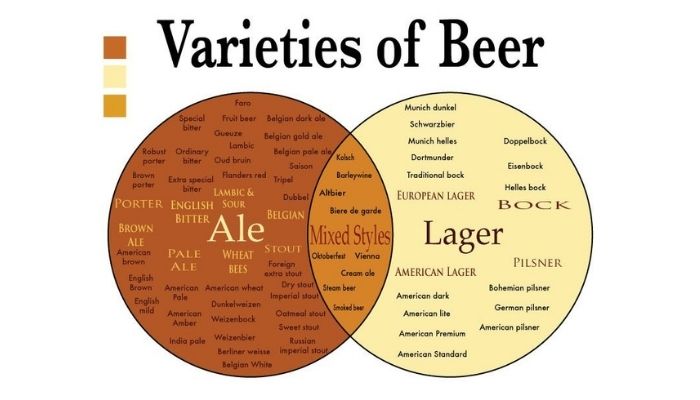
Image Source: Pinterest, Varieties of Beers
Depending on the brewer's methods and ingredients, the mouthfeel, alcohol content, appearance, and flavor of a beer can vary significantly within each variety. For example, pilsners and wheat beers are famous among those who like lighter, crisper brews, while porters and stouts are popular among those who prefer darker, deeper suds. Spicy Saisons, malty amber beers, and hop-forward pale ales all fall somewhere in the middle.
With countless beers available in the market, it might be overwhelming to choose just one. But equipped with a basic understanding of the differences between ale and lager, you'll be able to find the perfect pint.
Cheers!
Article By Aakriti Rawat, Beverage Trade Network
Header Image Source: Chow hound
Get rated by Quality, Value, and Packaging by the top retail buyers in the USA. Here is how to enter.